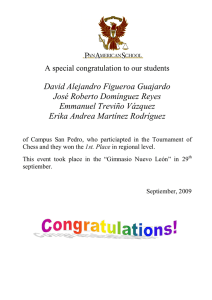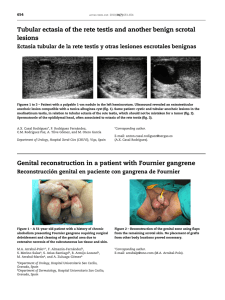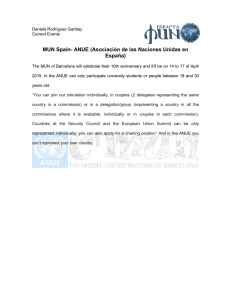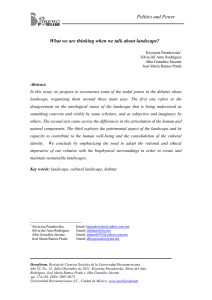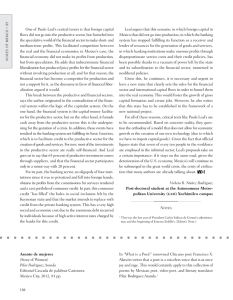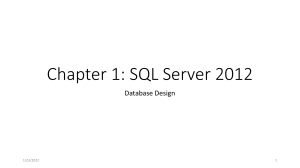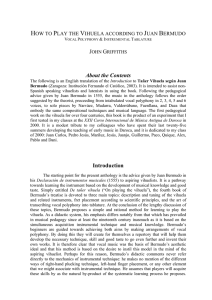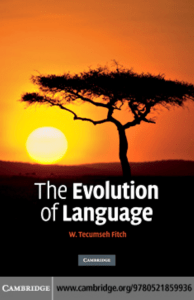Development of Voice-Based Tools for Accessibility to Computer
Anuncio
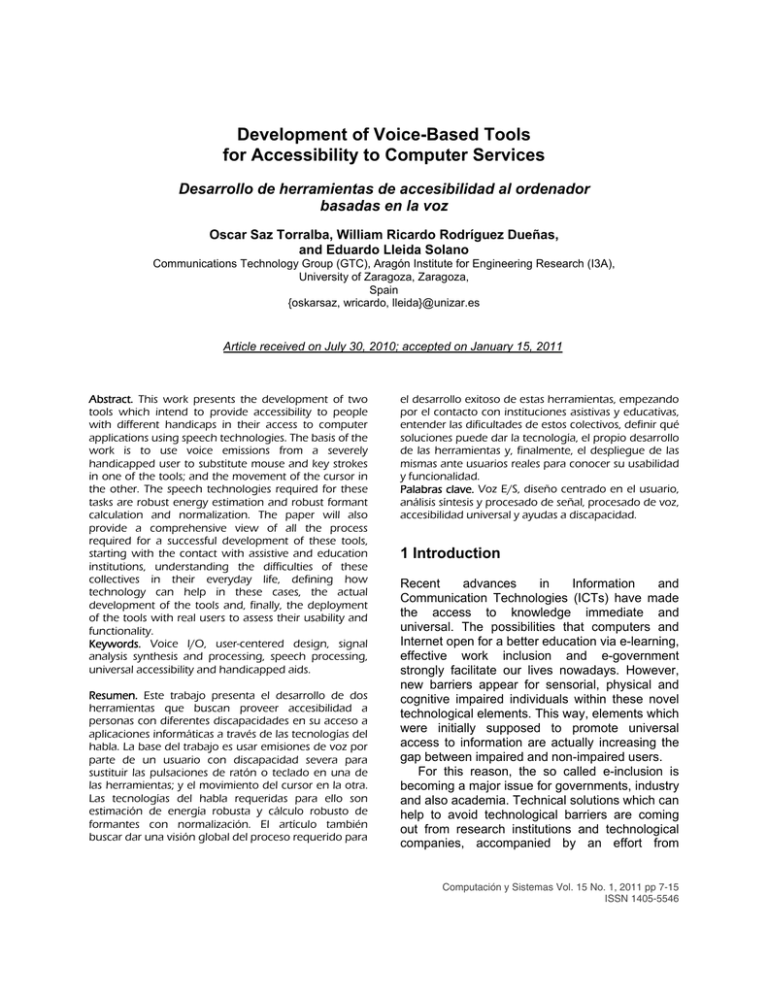
Development of Voice-Based Tools
for Accessibility to Computer Services
Desarrollo de herramientas de accesibilidad al ordenador
basadas en la voz
Oscar Saz Torralba, William Ricardo Rodríguez Dueñas,
and Eduardo Lleida Solano
Communications Technology Group (GTC), Aragón Institute for Engineering Research (I3A),
University of Zaragoza, Zaragoza,
Spain
{oskarsaz, wricardo, lleida}@unizar.es
Article received on July 30, 2010; accepted on January 15, 2011
Abstract. This work presents the development of two
tools which intend to provide accessibility to people
with different handicaps in their access to computer
applications using speech technologies. The basis of the
work is to use voice emissions from a severely
handicapped user to substitute mouse and key strokes
in one of the tools; and the movement of the cursor in
the other. The speech technologies required for these
tasks are robust energy estimation and robust formant
calculation and normalization. The paper will also
provide a comprehensive view of all the process
required for a successful development of these tools,
starting with the contact with assistive and education
institutions, understanding the difficulties of these
collectives in their everyday life, defining how
technology can help in these cases, the actual
development of the tools and, finally, the deployment
of the tools with real users to assess their usability and
functionality.
Keywords. Voice I/O, user-centered design, signal
analysis synthesis and processing, speech processing,
universal accessibility and handicapped aids.
Resumen. Este trabajo presenta el desarrollo de dos
herramientas que buscan proveer accesibilidad a
personas con diferentes discapacidades en su acceso a
aplicaciones informáticas a través de las tecnologías del
habla. La base del trabajo es usar emisiones de voz por
parte de un usuario con discapacidad severa para
sustituir las pulsaciones de ratón o teclado en una de
las herramientas; y el movimiento del cursor en la otra.
Las tecnologías del habla requeridas para ello son
estimación de energía robusta y cálculo robusto de
formantes con normalización. El artículo también
buscar dar una visión global del proceso requerido para
el desarrollo exitoso de estas herramientas, empezando
por el contacto con instituciones asistivas y educativas,
entender las dificultades de estos colectivos, definir qué
soluciones puede dar la tecnología, el propio desarrollo
de las herramientas y, finalmente, el despliegue de las
mismas ante usuarios reales para conocer su usabilidad
y funcionalidad.
Palabras clave. Voz E/S, diseño centrado en el usuario,
análisis síntesis y procesado de señal, procesado de voz,
accesibilidad universal y ayudas a discapacidad.
1 Introduction
Recent
advances
in
Information
and
Communication Technologies (ICTs) have made
the access to knowledge immediate and
universal. The possibilities that computers and
Internet open for a better education via e-learning,
effective work inclusion and e-government
strongly facilitate our lives nowadays. However,
new barriers appear for sensorial, physical and
cognitive impaired individuals within these novel
technological elements. This way, elements which
were initially supposed to promote universal
access to information are actually increasing the
gap between impaired and non-impaired users.
For this reason, the so called e-inclusion is
becoming a major issue for governments, industry
and also academia. Technical solutions which can
help to avoid technological barriers are coming
out from research institutions and technological
companies, accompanied by an effort from
Computación y Sistemas Vol. 15 No. 1, 2011 pp 7-15
ISSN 1405-5546
8 Oscar Saz Torralba, William Ricardo Rodríguez Dueñas, and Eduardo Lleida Solano
funding agencies and institutions [Cucchiarini et
al., 2008]. However, certain difficulties arise when
creating technical aids for the handicapped, which
limit the development of these devices. On one
hand, every user is unique in his/her specific
impairments and needs making that the tools or
systems developed have to be especially
designed for each one of them or have a high
capability of adaptation. Furthermore, developers
require the knowledge and help from experts in
different fields like sociology, education or
assistance to fully understand the needs of the
handicapped community and, hence, develop
tools which can be really useful for them.
The work presented in this paper is part of a
long running interest in new software and systems
based on speech technologies applied to
enhance the quality of life of the handicapped
community, which has lead previously to the set
of tools for automated speech therapy in
“Comunica” [Saz et al., 2009]. The basis of this
work is the collaboration with different
associations with interest in the education and
assistance of the handicapped: the Coordinator of
Associations for the Handicapped (CADIS) in
Huesca, Spain and the Spanish Confederation of
Associations for the Assistance to People with
Cerebral Palsy (ASPACE) in Huesca, Spain. This
collaboration has led to two different voice and
speech based solutions to provide accessibility to
computers that are presented and explained in
this work.
This paper is organized as follows: Section 2
will first provide an introduction to these barriers
which limit handicapped individuals accessing
information. Then, Sections 3 and 4 will present
the two approaches to use voice as assistive
interface in the access to computers by physically
handicapped individuals. In the end, Sections 5
and 6 will give the discussion and conclusions to
the work carried out.
2 Barriers in the Access to Information
There are several elements which limit the
possibilities for handicapped individuals to access
information and knowledge. This distinction relies
on the specific impairment of the user and the
Computación y Sistemas Vol. 15 No. 1, 2011 pp 7-15
ISSN 1405-5546
way it affects his/her motor function, cognitive
capabilities or sensorial faculties.
For persons who suffer severe physical
impairments, the control of the peripherals of a
computer can become impossible due to the
affections at the nervous system which control the
muscles and their movements; for instance, a
patient of cerebral palsy with spastic movements.
For this reason, computer interaction for these
people has to be fully adapted via the use of
devices which substitute or emulate these
peripherals. Virtual mice and virtual keyboards
simplify and reduce the workload of the physically
impaired user: They present sequentially in
screen the different options of the device
(directions of the mouse, keys in the keyboard)
and the user activates an external switch (or push
button) to select the option currently highlighted in
screen. The speed of the interaction when
working with these devices is very slow compared
to the normal interaction of an unimpaired user,
but the big difference that they make for a
handicapped user who, otherwise, could not
access the computer without them is so huge that
it quickly overcomes any difficulty in their use.
2.1 Human Computer Interfaces for the
Disabled
The need for new types of interfaces is, hence,
important for all these communities. These novel
proposals for interfaces include speech (which will
be reviewed later), movement tracking [Sánchez
Ortega et al., 2009] [Varona et al., 2008], eye
tracking [Palomo et al., 2009], brain computer
interface [Iturrate et al., 2009], or any other
possible interface which permits for a more
natural human machine interaction despite the
impairments of the user. Several research groups
worldwide are developing new proposals of these
enhanced interfaces, which, in some cases lead
to devices which can be finally applied to a certain
part of the handicapped population.
Among these possibilities, it is usually
considered that speech (or voice) can provide
these users with an enhanced interface that
overcomes their existing limitations. Speech is a
very natural way of communication and the most
common interface in human communication, so it
Development of Voice-Based Tools for Accessibility to Computer Services 9
Fig. 1. Signal processing for voice-based triggering of mouse strokes
has very often been proposed for natural human
machine interaction.
Different approaches have been studied
through research for creating speech interfaces
for control of external appliances through
Automatic Speech Recognition (ASR) [Hawley et
al., 2003], [Sanders et al., 2002], [Sharma &
Hasegawa-Johnson, 2009] which can be easily
translated to computer control or many other
applications. Also, emulation of joystick or mouse
peripherals has been proved to be possible by the
detection of vowels produced by the user [Bilmes
et al., 2006], [Harada et al., 2008]. Devices which
translate difficult speech from a handicapped user
to a clearer and more intelligible speech have
also been developed to provide accessibility
[Creer et al., 2009].
However, more work is required in this area.
The specificity of every user and the difficulty to
translate cases of success from previous works to
different people and conditions make necessary
to continue on the research of speech and voice
as alternative interaction. This research has to
present two edges: First, increase the theoretic
knowledge on the different disorders and its
influence on automated systems like ASR; and,
second, the rapid development of tools based on
these systems which can actually provide a
solution to people.
3 Voice-Based Triggering of Keyboard
and Mouse Events
As mentioned, voice can, in many cases, suppose
an easier interface for users with a limited control
of movements, overcoming the limitations of
physical devices. However, motor disabilities very
often produce also a deterioration of the
articulatory skills of the patient in the form of
dysarthria, dysphonia and other speech
impairments. In these cases, speech can be
extremely unintelligible and becomes a serious
challenge for automated speech-based systems.
“Vozclick” was developed with the aim of
substituting the use of physical triggering of
keyboard and mouse events. It directly relies on
the voice emission of the user, independently of
the content of the utterance, to avoid limitations in
usability due to the possible speech impairments
of the user. It performs a signal processing of the
input audio signal to detect pulses of voice in the
user’s emission, as it can be seen in Figure 1.
The system captures the audio from the user
and performs noise reduction by the use of a
spectral subtraction technique to avoid false
alarms due to external noises in the environment
or to electrical noise in the audio equipment. The
energy of the audio frame is calculated and, when
a certain intensity threshold (Ethreshold) is reached
and maintained during a predefined amount of
time
t
(tminimum<t<tmaximum)
the
software
automatically triggers the desired event (mouse
click or key stroke).
The user interface of “VozClick” in Figure2 was
designed to allow a quick configuration of all the
key elements in the application. The person who
assists the disabled user can set up the values of
the intensity and duration of the voice emission to
be recognized as a voluntary action of the user
(Ethreshold, tminimum and tmaximum). It can be decided
also whether to apply noise subtraction or not, to
consider only voiced or unvoiced segments of
speech; and, finally, the event to be triggered by
voice (left button mouse click or specific key
stroke).
Computación y Sistemas Vol. 15 No. 1, 2011 pp 7-15
ISSN 1405-5546
10 Oscar Saz Torralba, William Ricardo Rodríguez Dueñas, and Eduardo Lleida Solano
For this reason, a spectral subtraction method
based on Minimum Mean Square Error Log
Spectral Amplitude (MMSE-LSA) estimation is
applied [Ephraim & Malah, 1984][Ephraim &
Malah, 1985] to the captured speech signal. This
method estimates a filter G in the spectral domain
for each frame n which is a function of the
estimation of the noise present on the spectrum
and the estimated Signal to Noise Ratio (SNR) for
the frame. The estimation of the power spectral
density of the noise, required to estimate the
SNR, is readjusted every unvoiced frame to track
dynamically changes in the noise spectrum due to
possible variations in the environment.
Fig. 2. “VozClick” user interface
3.1 Energy
Reduction
Estimation
and
Noise
The estimation of the energy is performed after
windowing the input signal in frames of 25
milliseconds with a 50% overlap. The instant
energy for the n-th frame is calculated in Eframe as
in Equation (1).
(1)
To reduce the high variability of the input
energy between frames, which may lead to
inaccurate detection of the rising and descending
slopes in the oral production of the user, an
smoothed calculation of the logarithm of the
energy (logE) is used for each frame n as in
Equation (2).
log
0.1
0.9
log
log
(2)
1
Although this method for calculating the
energy is very simple, it works accurately with
signals with a low presence of noise, but it can be
extremely dependent on the input background
energy due to the many sources of sound which
are not originated by the user. These background
noises, which include external sounds as well as
internal electronic noises, may limit the
functionality of the tool, as they would produce a
large amount of false alarms in the means of
triggering of events not desired by the user.
Computación y Sistemas Vol. 15 No. 1, 2011 pp 7-15
ISSN 1405-5546
4 Vowel-Controlled Emulation of
Mouse
Users with more capabilities in their control of
phonation and articulation might find “VozClick”
too simple for their interests and possibilities.
Even when an ASR system would still not be
suitable for these users, vowels can be used to
build a whole system which allows to fully emulate
a device like a mouse as it has been proved
before for English [Bilmes et al., 2006].
“VocalClick” made use of the knowledge
acquired in robust formant estimation and vowel
detection for different users via formant
normalization, as seen in Figure 3. The audio
captured from the user is followed by a process
for the estimation of the first two formant
frequencies in the speech (F1 and F2). This
process performs a Linear Predictive Coding
(LPC) analysis of the signal, followed by a liftering
in the homomorphic domain to avoid the influence
of the fundamental frequency (or pitch) in the
formant estimation. The calculated formant values
are normalized according to the relationship
between physical parameters of the user (height
and
vocal
tract
length)
obtaining
the
corresponding normalized formant frequencies
F1N and F2N [Rodríguez and Lleida, 2009]. The
vowel corresponding to the normalized formant
values is decoded as the closest vowel in the
formant map and the corresponding mouse
movement is performed. The use of formant
normalization allows using the same formant map
Development of Voice-Based Tools for Accessibility to Computer Services 11
Fig. 3. Signal processing for vowel control of mouse
for all users, independently of their physical
characteristics.
The user interface of “VocalClick” in Figure 4
indicates how different vowels act in different
spatial directions (/a/ for right, /e/ for up, /i/ for left
and /o/ or /u/ for down). Other elements can also
be configured, especially the gender and height of
the person; these two data allow for an accurate
formant normalization which can map the formant
map of a given user to the standard formant map.
There are also thresholds for the intensity and
duration of the vocalic emission in a similar as
how “Vozclick” worked, to avoid unwanted noises
triggering the system.
analysis. The main idea within the homomorphic
analysis is the deconvolution of a segment of
speech x(n) into a component representing the
vocal tract impulse response h(n), and a
component representing the excitation source
e(n) as in Equation (3).
(3)
The way in which such separation is achieved
is through linear filtering of the cepstrum, defined
as the inverse Fourier transform of the log
spectrum of the signal. As the cepstrum in the
complex domain is not suitable to be used
because of its high sensitivity to phase [Rabiner &
Schafer, 1978], the real-domain cepstrum c(n)
defined by Equation (4) is used, where X(k) is the
N-point Fourier transform of the input speech
signal x(n).
1
ln|
|
0
(4)
1
Fig. 4. “VocalClick” user interface
4.1 Robust Formant Estimation
The conventional autocorrelation method using
LPC works well in signals with long pitch period
(low-pitched). As the pitch period of high-pitched
speech is small, the periodic replicas cause
aliasing of the autocorrelation sequence. In other
words, the accuracy of the LPC method
decreases as the fundamental frequency F0 of
speech increases [Rahman & Shimamura, 2005].
In that case, it is required to separate these
effects in order to obtain formants not
contaminated by F0 by means of homomorphic
The values of c(n) around the origin
correspond primarily to the vocal tract impulse
information, while the farthest values are affected
mostly by the excitation. Knowing previously the
value of the pitch period (Tpitch), from the LPC
analysis using the autocorrelation method, it is
possible to filter the cepstrum signal (liftering) and
use the liftered signal to find the formant
frequencies. After the liftering process, the
formant frequencies without the pitch influence
are obtained using the original LPC method,
increasing the formant estimation accuracy.
4.2 Formant Normalization
The main difficulty in decoding the uttered vowel
by a speaker knowing only the formants
Computación y Sistemas Vol. 15 No. 1, 2011 pp 7-15
ISSN 1405-5546
12 Oscar Saz Torralba, William Ricardo Rodríguez Dueñas, and Eduardo Lleida Solano
frequencies from the user’s voice is that different
speakers have different formant values for the
same vowel. More precisely, speakers with
shorter vocal tract lengths (children and women)
tend to have higher F1 and F2 values than adult
males, producing an uncertainty in the vowel
decoding. To avoid this, once the current user’s
vocal tract length is estimated, formant
normalization allows translating the formant
frequencies of a given speaker to a standard
formant map which can be used for decoding the
uttered vowel.
If no a priori information is known from the
speaker, like gender or age, the estimation of the
vocal tract length can be done from the formant
frequencies calculated directly from speech.
Considering the vocal tract as a uniform lossless
acoustic tube, its resonant frequencies are given
by Equation (5) and they are uniformly spaced,
where v = 35300 cm/s is the speed of sound at
35º C, and l is the length of the uniform tube in
cm.
4
2
1
1.2.3 …
(5)
The estimation of the length can be reduced to
fitting the set of resonance frequencies of the
uniform tube [Necioglu et al., 2000], which are
determined solely by its length l. Therefore, the
problem can be approximated to minimizing
Equation (6), as the sum of the difference
between the measured formants and the
resonances of the uniform tube. From [Burhan et
al., 2000], this error measure can be simplified in
the second part of Equation (6) using the distance
function between the M measured formants and
the odd resonances of a uniform tube, (2k-1)F1.
, 2
1
4
2
(6)
1
uniform tube (F1), calculated from previous
equations as in Equation (8).
(7)
4
1
2
1
(8)
A more straightforward possibility, if the
speaker provides information on gender and
height is to directly estimate the vocal tract length
applying the known relationships between these
parameters and the vocal tract. This is the
process performed in “VocalClick”, which makes
use of previous work on the study of the
relationship between physical parameters and the
vocal tract [Rodríguez & Lleida, 2009]. If this
could not be possible, the vocal tract length could
be estimated through an enrollment session
uttering the 5 Spanish vowels (/a/, /e/, /i/, /o/ and
/u/) and performing the process depicted
previously.
Once the speaker’s vocal tract length is
estimated, the formant frequencies Fk obtained
can be normalized with it. The formant
normalization used in this work is based on the
hypothesis that the vocal tract configurations of
different speakers are similar to each other and
differ only in length [Wakita, 1977]. Based upon
this hypothesis for normalization, it is necessary
to compute the resonance frequencies of an
acoustic tube when the length of the tube l is
varied to a reference length lR without altering its
shape. Hence, the normalized formants FkN are
computed in Equation (9) by multiplying the
unnormalized formants by the length factor, l/lR,
with lR fixed at 17.5cm, and l the vocal tract length
obtained previously.
(9)
Finally, the vocal tract length can be obtained
with the expression in Equation (7) which makes
use of the estimated resonance frequency of the
Computación y Sistemas Vol. 15 No. 1, 2011 pp 7-15
ISSN 1405-5546
This formant estimation and normalization
methods were evaluated for providing Vocal Tract
Length Normalization (VTLN) in an ASR task
[Rodríguez et al., 2010]. The results show that the
Development of Voice-Based Tools for Accessibility to Computer Services 13
technique is accurate in detecting differences
among vocal tracts of different individuals in
comparison with similar techniques for vocal tract
normalization based either in parametric
approaches [Gouvea & Stern, 1997] or in
statistical approaches [Lee and Rose, 1998].
processing or work with presentation programs
with the help of devices which help them to
overcome their physical handicaps, as this is the
case. “VozClick” has helped them to avoid the
use of physical switches which, in some cases,
produced difficulty of use and excessive physical
load resulting in discomfort and pain.
5 Deployment and Discussion
6 Conclusions
The main point of discussion in the development
of assistive tools for the handicapped is always
whether the creations which arise from
technological developers are actually helpful or
not for the intended users. It is not rare the case
where technological solutions with complex
engineering processing within them end up being
forgotten due to the fact that they do not match
the special requirements of the users.
The technical aids presented here counted
with the collaboration of different associations and
institutions for their development and posterior
deployment. CADIS-Huesca and ASPACEHuesca actively participated in the development
of “VozClick” and “VocalClick”, through several
coordinating meetings and evaluation sessions
with 3 users affected with cerebral palsy of the
assistive center of ASPACE in Huesca. These
meetings served to make new proposals in the
tools, including the use of noise reduction
methods to avoid the influence of environmental
and electrical noises. “VozClick” and “VocalClick”
are now available for the whole community
through the website of “Comunica”1, altogether
with extra material and tutorials, in an effort to
widespread every tool which can serve to improve
the quality of life of part of the handicapped
community.
One of the most difficult tasks when
developing technical aids is to find a way to
validate the usefulness of the developed
technologies. Currently, a group of users of
ASPACE-Huesca with severe cerebral palsy are
using “VozClick” to complement virtual mice and
keyboards for interacting with computers. These
users have mid to high cognitive capabilities so
they are able to perform several tasks like
navigating the Internet, perform simple text
1
As conclusion to this work, a set of technical aids
for providing accessibility to computer and
Internet services have been presented. These
tools propose the use of different speech
technologies as a way to solve the gap that
sensorial, physical and cognitive disabled users
suffer in their access to new technologies. These
technologies have been voice detection and
robust formant estimation. The maturity reached
in these technologies at research and commercial
levels made them feasible to be used in these
special tasks, where the adaptability to the user
and the robustness to different situations are key
points in the success of these developed tools.
This work has been acknowledged by the
foundation Physical Disabled of Aragón (DFA) as
finalist in their XIII Awards for Universal
Accessibility 2010 in the category of Accessibility
in Information and Communication Technologies.
This award recognizes the effort of individuals,
institutions, companies and academic groups to
reduce the barriers of handicapped people (not
only physical handicapped) in their access to
several areas of their life, including mobility,
access to information and communication.
Future work has to deal with the use of more
advance systems for oral interfaces. ASR can be
applied to a large number of users with handicaps
whose speech is still intelligible and recognizable.
Adaptation and personalization are the key points
to develop successful speech systems for users
with special needs. This adaptation allows the
system to learn the special acoustic properties in
the user speech, the lexical variants in the speech
and the special vocabulary and syntax of a
specific user. All this can lead to personalized
systems that can accompany the person through
different tasks and activities.
http://www.vocaliza.es/cadis.html
Computación y Sistemas Vol. 15 No. 1, 2011 pp 7-15
ISSN 1405-5546
14 Oscar Saz Torralba, William Ricardo Rodríguez Dueñas, and Eduardo Lleida Solano
Acknowledgements
The authors want to thank the following people:
Antonio Escartín for his work; Marta Peña and the
staff from CADIS-Huesca; Verónica Bermúdez,
Laura Abarca, Sara Mejuto and employees and
users of ASPACE-Huesca. This work was
supported by project TIN2008-06856-C05-04 from
MEC of the Spanish government, the Santander
Bank Scholarship, and a collaboration project
between CADIS-Huesca and the University of
Zaragoza founded by Caja de Ahorros de la
Inmaculada (CAI), Instituto Aragonés de Servicios
Sociales (IASS) and Diputación Provincial de
Huesca (DPH).
Referencias
1. Bilmes, J.-A., Malkin, J., Li, X., Harada, S., Kilanski,
K., Kirchhoff, K., Wright, R., Subramanya, A.,
Landay, J.-A., Dowden, P. & Chizeck, H. (2006). The
Vocal Joystick. 2006 IEEE International Conference on
Acoustics, Speech and Signal Processing (ICASSP
2006), Toulouse, France, 1, 625-628.
2. Necioglu, B.F., Clements, M.A., & Barnwell, T.P.
(2000). Unsupervised Estimation of the Human Vocal
Tract Length over Sentence Level Utterances. 2000
IEEE International Conference on Acoustics, Speech
and Signal Processing (ICASSP 2000), Istanbul,
Turkey, 3, 1319-1322.
3. Creer, S. M., Green, P. D., Cunningham, S. P. &
Fatema, K. (2009). Personalizing Synthetic Voices for
People with Progressive Speech Disorders: Judging
Voice Similarity. 10th Annual Conference of the
International Speech Communication Association
(INTERSPEECH 2009), Brighton, United Kingdom,
1427-1430.
4. Cucchiarini, C., Lembrechts, D. & Strik, H. (2008).
HLT and Communicative Disabilities: The Need for CoOperation between Government, Industry and
Academia. Language and Speech Technology
Conference (LangTech 2008), Rome, Italy, 125-128.
5. Ephraim, Y. & Malah, D. (1984). Speech
Enhancement Using a Minimum Mean-Square Error
Short-Time Spectral Amplitude Estimator. IEEE
Transactions on Acoustic, Speech Signal Processing,
32(6), 1109-1121.
6. Ephraim, Y. & Malah, D. (1985). Speech
Enhancement Using A Minimum Mean-Square Error
Log-Spectral Amplitude Estimator. IEEE Transactions
Computación y Sistemas Vol. 15 No. 1, 2011 pp 7-15
ISSN 1405-5546
on Acoustic, Speech Signal Processing, 33(2), 443–
445.
7. Gouvea, E.-B., & Stern, R.-M. (1997). Speaker
Normalization Through Formant-Based Warping Of
The Frequency Scale. 5th European Conference on
Speech
Communication
and
Technology
(EUROSPEECH 1997), Rhodes, Greece, 1139–1142.
8. Harada, S., Landay, J.-A., Malkin, J., Li, X. &
Bilmes, J.A. (2008). The Vocal Joystick: Evaluation of
Voice-Based Cursor Control Techniques for Assistive
Technology. Disability and Rehabilitation: Assistive
Technology, 3(1), 22-34.
9. Hawley, M., Enderby, P., Green, P., Brownsell, S.,
Hatzis, A., Parker, M., Carmichael, J., Cunningham,
S., O’Neill, P. & Palmer, R. (2003). STARDUST:
Speech Training And Recognition for Dysarthic Users
of Assistive Technology. 7th European Conference for
the Advancement of Assistive Technology (AAATE
2003), Dublin, Ireland, 959-963.
10. Iturrate, I., Antelis, J.-M., Kübler, A. & Mínguez, J.
(2009). A Non-Invasive Brain-Actuated Wheelchair
based on a P300 Neurophysiological Protocol and
Automated Navigation. IEEE Transactions on
Robotics, 25(3), 614–627.
11. Lee, L. & Rose, R. (1998). A Frequency Warping
Approach
to
Speaker
Normalization.
IEEE
Transactions on Speech and Audio Processing, 6(1),
49–60.
12. Palomo, P., González, T., Rivas, R., Irazabal I. &
Ruiz, A. (2009). IRISCOM. Proyecto IRIS. IV Jornadas
Iberoamericanas de Tecnologías de Apoyo a
Discapacidad, Las tecnologías de apoyo en parálisis
cerebral, Madrid, Spain, 87-91.
13. Rodríguez, W.-R. & Lleida, E. (2009). Formant
Estimation in Children’s Speech and its application for
a Spanish Speech Therapy Tool. 2009 Workshop on
Speech and Language Technologies in Education
(SLaTE 2009), Wroxall Abbey Estates, Warwickshire,
United Kingdom, 81-84.
14. Rodríguez, W.-R., Saz, O., Miguel, A. & Lleida, E.
(2010). On Line Vocal Tract Length Estimation for
Speaker Normalization in Speech Recognition. VI
Jornadas en Tecnología del Habla and II Iberian
SLTech Workshop (Fala 2010), Vigo, Spain, 119-122.
15. Sánchez Ortega, P.-L., Cámara Nebreda, J.-M. &
Núñez Angulo, B. (2009). Interacción Con Ordenador
Mediantes Dispositivos Inalámbricos Para Usuarios
Con
Movilidad
Muy
Reducida.
Colaboración
Universidad de Burgos – APACE. IV Jornadas
Iberoamericanas de Tecnologías de Apoyo a
Development of Voice-Based Tools for Accessibility to Computer Services 15
Discapacidad, Las tecnologías de apoyo en parálisis
cerebral, Madrid, Spain, 45-49.
16. Sanders, E., Ruiter, M., Beijer, L. & Strik, H. (2002).
Automatic Recognition of Dutch Dysarthric Speech: A
Pilot Study. 7th International Conference on Spoken
Language Processing (INTERSPEECH 2002), Denver
CO, USA, 661-664.
17. Saz, O., Lleida, E., Abarca, L. & Mejuto, S. (2009).
Mouseclick: Acceso Al Ordenador A Través De La
Voz. IV Jornadas Iberoamericanas de Tecnologías de
Apoyo a Discapacidad, Las tecnologías de apoyo en
parálisis cerebral, Madrid, Spain, 63-67.
18. Saz, O., Yin, S.-C., Lleida, E., Rose, R., Vaquero, C.
& Rodríguez, W.-R. (2009). Tools and Technologies
for Computer-Aided Speech and Language Therapy.
Speech Communication, 51(10), 948-96.
19. Rabiner, L.-R. & Schafer, R.-W. (1978). Digital
Processing of Speech Signals. Englewood Cliffs NJ,
USA: Prentice Hall.
20. Rahman, M.-S. & Shimamura, T. (2005). Formant
Frequency Estimation of High-Pitched Speech by
Homomorphic Prediction. Acoustical Science and
Technology, 26(6), 502-510.
21. Sharma, H.-V. & Hasegawa-Johnson, M., (2009).
Universal Access: Speech Recognition for Talkers with
Spastic Dysarthria. 10th Annual Conference of the
International Speech Communication Association
(INTERSPEECH 2009), Brighton, United Kingdom,
1451–1454
22. Varona, J., Manresa-Yee, C. & Perales, F.-J. (2008).
Hands-Free Vision-Based Interface for Computer
Accessibility, Journal of Network and Computer
Applications, 31(4), 357–374.
23. Wakita, H. (1977). Normalization of Vowels by Vocal
Tract Length and its Application to Vowel Identification.
IEEE Transactions on Acoustic, Speech Signal
Processing, 25(2), 183-192.
Carnegie Mellon University in Pittsburgh, USA. His
research interests are new applications of speech
technologies such as oral interfaces for handicapped
individuals and computer-assisted language learning.
William Ricardo Rodríguez
Dueñas
He received a B.Sc. in Biomedical Engineering by the
University of Science and Development in 2002, a M.Sc. in
Biomedical Engineering in 2008 by the University of
Zaragoza and a Ph.D. by the University of Zaragoza in
2010. He currently is an assistant professor at the
Universidad Antonio Nariño in Bogotá, Colombia. His
research interests are technologies and interfaces for
rehabilitation and speech systems for children.
Eduardo Lleida Solano
He received a B.Sc. in Telecommunications Engineering
by the Polytechnic University of Catalonia in 1985 and a
Ph.D. by the Polytechnic University of Catalonia in 1990.
He currently is a full professor at the Department of
electrical engineering and communications of the
University of Zaragoza. His research interests are related
to speech processing in different areas like acoustics,
automatic speech recognition, speech biometrics and oral
interfaces.
Oscar Saz Torralba
He received a B.Sc. in Telecommunications Engineering
by the University of Zaragoza in 2004 and a Ph.D. by the
University of Zaragoza in 2009. He is currently a Fulbright
scholar at the Language Technologies Institute at
Computación y Sistemas Vol. 15 No. 1, 2011 pp 7-15
ISSN 1405-5546
